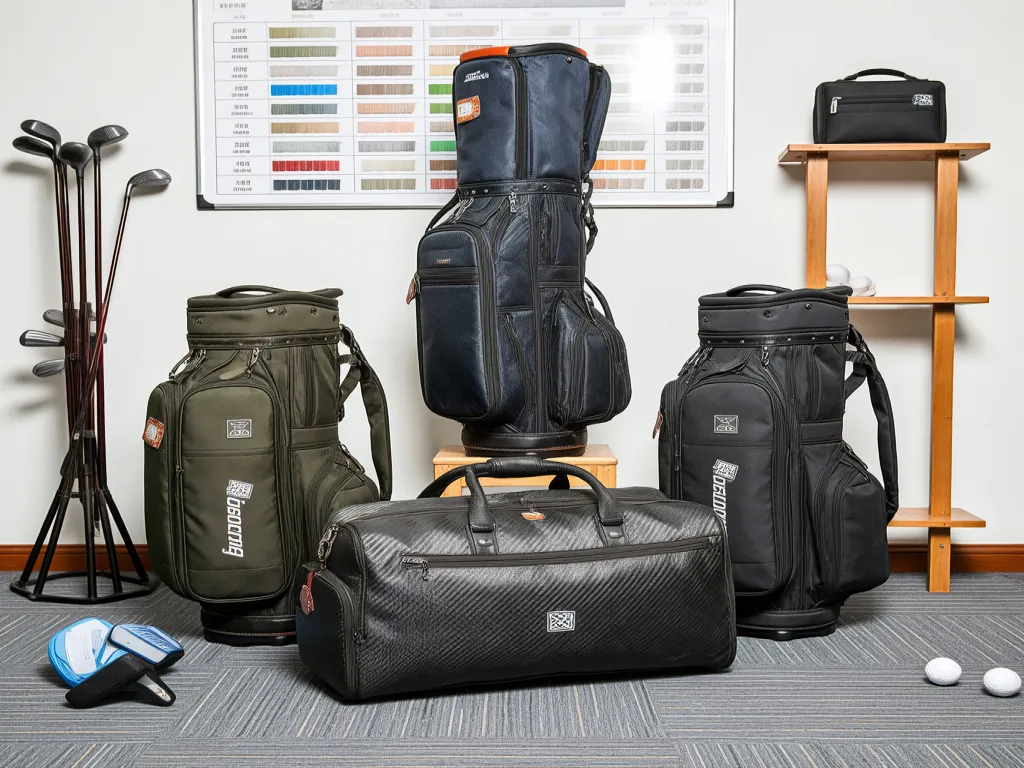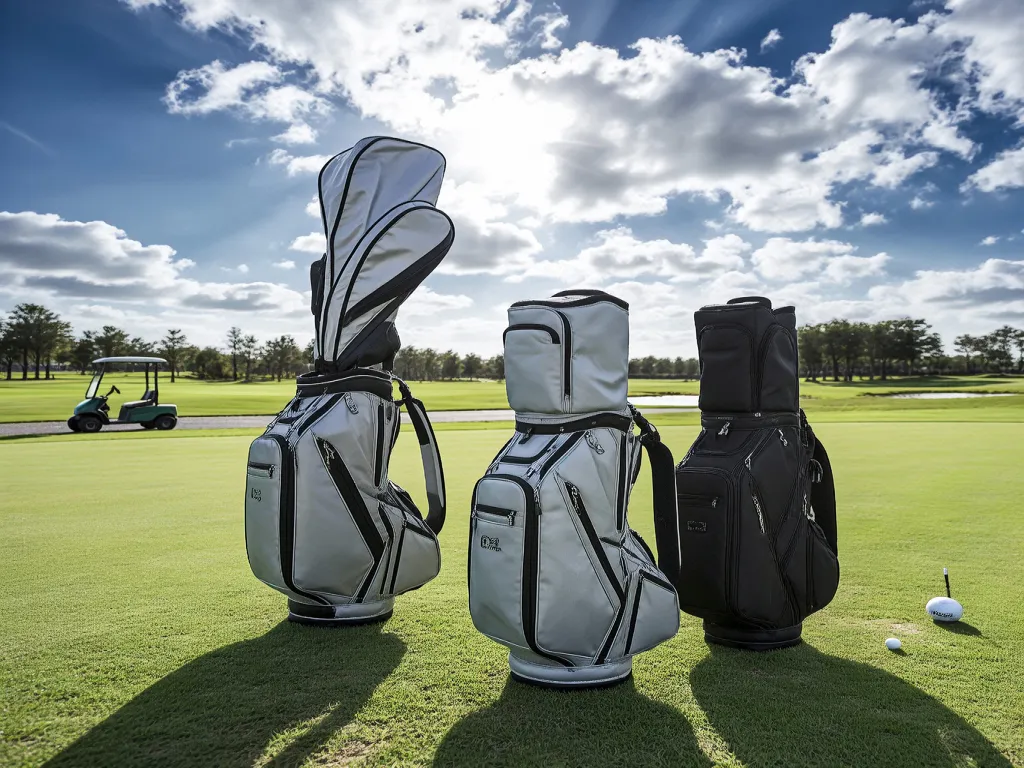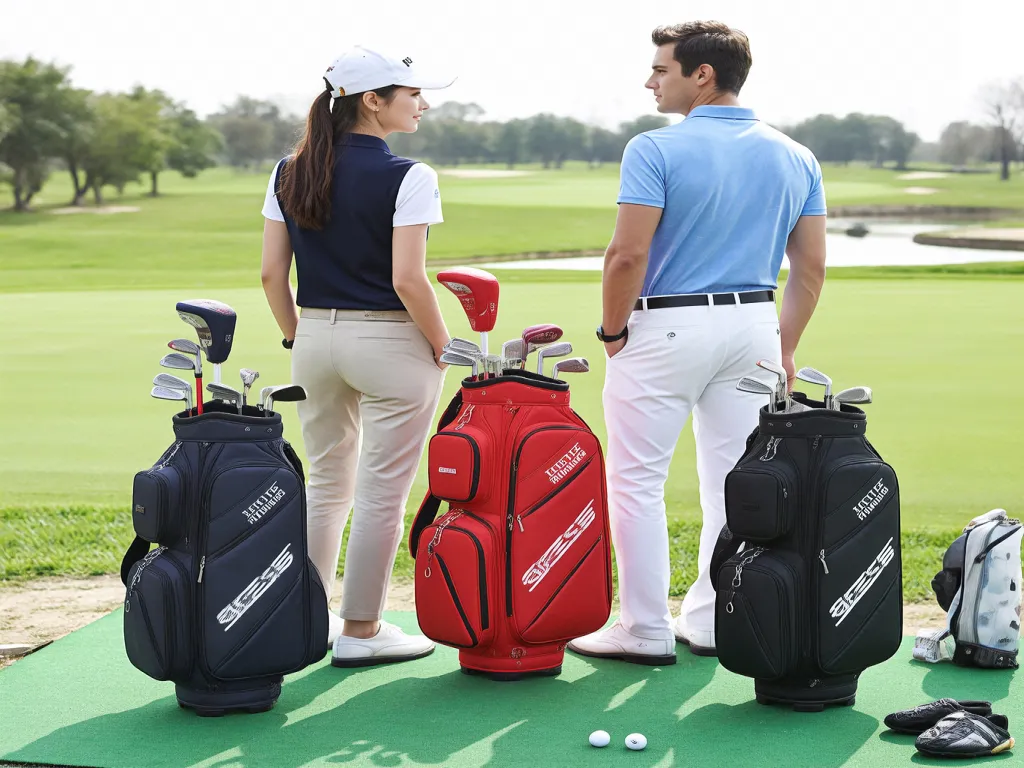Golf Travel Bags Buyer’s Bible
Every golfer knows the struggle of finding the right golf travel bag. You want something that’s durable, functional, and just the right size for all your gear. But with so many options out there, how do you choose? That’s where we come in. This ultimate guide dives deep into golf travel bags, breaking down everything from materials to features to size. By the end, you’ll know exactly what to look for in your next golf travel bag. Ready to find your perfect match?

Material Secrets: From Durable Nylon to Lightweight Carbon Fiber, Analyzing the Pros and Cons of Different Materials for Travel Bags to Help You Choose the Best Material Based on Usage Scenarios
When it comes to golf travel bags, the material is a crucial factor that determines the bag’s durability, weight, and overall performance. With so many options available, it can be overwhelming to choose the right one. But fear not! In this section, we’ll delve into the most common materials used in golf travel bags and analyze their pros and cons, helping you make an informed decision based on your specific needs.
Let’s start with nylon, a material that has been a staple in the travel bag industry for years. Nylon is known for its exceptional durability and resistance to wear and tear. It can withstand the rigors of frequent travel, including being tossed around by airport baggage handlers. Nylon travel bags are also relatively affordable, making them a popular choice among budget-conscious golfers. However, nylon can be a bit heavier compared to other materials, which might be a drawback if you’re looking for a lightweight option.
Next up is polyester, another synthetic material that offers a good balance of durability and weight. Polyester travel bags are often more lightweight than nylon ones while still providing decent protection for your golf clubs. They are also water-resistant, which is a plus if you’re traveling in wet conditions. However, polyester may not be as durable as nylon in the long run, especially if it’s exposed to rough handling.
For those who prioritize lightweight construction, carbon fiber is the way to go. Carbon fiber travel bags are incredibly light, making them a dream to carry around. They are also extremely strong and rigid, providing excellent protection for your clubs. However, carbon fiber bags come with a hefty price tag, which might be a deterrent for some golfers. Additionally, they can be more prone to cracking or chipping if not handled with care.
Leather travel bags offer a touch of luxury and sophistication. They are not only stylish but also durable and can develop a beautiful patina over time. However, leather bags are often the heaviest option and require more maintenance to keep them looking their best. They are also not as water-resistant as synthetic materials, so you’ll need to be extra careful in wet weather.
Finally, there are hybrid materials that combine the best of different worlds. For example, some travel bags may feature a nylon or polyester exterior with a carbon fiber frame for added strength and rigidity. These hybrid bags offer a good balance of durability, weight, and protection, but they can also be more expensive than single-material options.
Now that you’re familiar with the different materials used in golf travel bags, how do you choose the best one for your needs? Consider your travel frequency, the conditions you’ll be traveling in, and your budget. If you travel frequently and need a durable bag that can withstand rough handling, nylon or a hybrid material might be your best bet. If weight is a major concern, carbon fiber or a lightweight polyester bag could be the way to go. And if you’re looking for a stylish and durable option that can last for years, leather might be worth the investment.
Nylon: The Workhorse of Travel Bags
Nylon has long been the go-to material for travel bags, and for good reason. It’s incredibly durable, able to withstand the bumps and bruises of travel without showing signs of wear. Nylon bags are also relatively easy to clean, which is a plus if you’re prone to getting your bag dirty on the course. However, the weight of nylon can be a drawback, especially if you’re already carrying a heavy load of golf clubs and accessories. If you’re looking for a bag that can take a beating and still look good, nylon is a solid choice.

Polyester: Lightweight and Water-Resistant
Polyester is a popular alternative to nylon, offering a lighter weight and good water resistance. It’s a great option for golfers who want a bag that’s easy to carry and won’t be weighed down by rain or moisture. Polyester bags are also often more affordable than nylon ones, making them a budget-friendly choice. However, they may not be as durable as nylon in the long run, so if you’re a frequent traveler, you might want to consider a more robust option.
Carbon Fiber: The Lightweight Champion
Carbon fiber is the ultimate lightweight material for travel bags. It’s incredibly strong and rigid, providing excellent protection for your clubs while keeping the bag’s weight to a minimum. Carbon fiber bags are perfect for golfers who want to minimize the strain on their shoulders and back. However, the high cost of carbon fiber can be a significant barrier for many. If you’re willing to invest in a top-of-the-line bag, carbon fiber is definitely worth considering. To learn more about the durability and performance of carbon fiber bags, explore this guide on hard vs. soft golf travel bags.
Leather: Timeless Elegance and Durability
Leather travel bags offer a classic and sophisticated look that never goes out of style. They are not only stylish but also durable, able to withstand the test of time. Leather bags can develop a beautiful patina over the years, adding to their charm. However, they are often the heaviest option and require more maintenance to keep them in good condition. If you’re looking for a bag that will make a statement and last for decades, leather is the way to go.
Hybrid Materials: The Best of Both Worlds
Hybrid materials combine the strengths of different materials to create a travel bag that offers the best of both worlds. For example, a bag with a nylon or polyester exterior and a carbon fiber frame can provide the durability and water resistance of synthetic materials with the strength and rigidity of carbon fiber. These hybrid bags are often more expensive than single-material options, but they can be a great investment for golfers who want a high-performance bag that meets all their needs.

Function comparison: waterproof, shock resistant, anti-theft… essential functions of modern golf travel bags, and how to choose according to personal needs
When it comes to choosing the perfect golf travel bag, understanding the features that matter most is crucial. Whether you’re a casual golfer or a seasoned pro, having a bag that caters to your specific needs can make all the difference in your golfing experience. Let’s dive into the essential features of modern golf travel bags and help you decide which ones are worth prioritizing based on your personal requirements.
First up, let’s talk about waterproofing. If you’re someone who golfs in all weather conditions or frequently travels to destinations with unpredictable climates, a waterproof golf travel bag is a must-have. These bags are typically made from materials like coated nylon or polyester, which offer excellent water resistance. They often feature sealed seams and waterproof zippers to ensure that your clubs and gear stay dry even in the wettest conditions. On the flip side, if you mostly golf in sunny climates or don’t mind a little rain, you might be able to skip this feature and opt for a bag with other priorities.
Next, let’s consider shock absorption. Golf clubs are valuable investments, and you want to protect them from damage during transit. Shock-absorbing features in golf travel bags, such as padded dividers and reinforced corners, can help cushion your clubs from bumps and impacts. This is especially important if you’re traveling by air, where bags are often handled roughly. However, if you’re mostly driving to your golf courses and don’t anticipate much rough handling, you might be able to get away with a bag that has less emphasis on shock absorption.
Now, let’s talk about security features. Golf travel bags can be expensive, and you don’t want to risk losing your clubs or gear to theft. Many bags now come with built-in security features like combination locks, TSA-approved locks, or even hidden compartments for storing valuable items. If you’re traveling to areas with high theft rates or simply want peace of mind, investing in a bag with robust security features is a smart choice. On the other hand, if you’re mostly golfing in safe, familiar locations, you might not need to prioritize this feature as much.
Other features to consider include the number and size of pockets, the ease of carrying the bag (such as with wheels or padded straps), and the overall durability of the bag. Some bags even come with additional perks like a built-in shoe compartment, a rain cover, or a cooler pocket for storing drinks and snacks. For an example of a well-designed travel bag with extra features, check out our glossy PVC travel bag.
So, how do you decide which features to prioritize? It all comes down to your personal needs and preferences. Think about how often you travel with your golf clubs, the conditions you’ll be golfing in, and what you value most in a golf travel bag. By weighing these factors against the features available, you can make an informed decision that ensures you get the most out of your investment.
Waterproofing: Protecting Your Gear from the Elements
Waterproofing is a feature that can save you a lot of headaches down the road. Imagine arriving at your golf destination only to find that your clubs are soaked through because your bag wasn’t waterproof. Not only is this inconvenient, but it can also damage your clubs and gear over time. Look for bags that are explicitly labeled as waterproof or water-resistant, and check the materials and construction to ensure they can withstand wet conditions. Some bags even come with a rain cover that you can quickly pull over the bag in case of sudden downpours.
Shock Absorption: Keeping Your Clubs Safe During Transit
Shock absorption is another critical feature to consider, especially if you’re traveling by air. Airlines are notorious for rough handling of luggage, and your golf clubs can easily get damaged in transit. Bags with padded dividers and reinforced corners can help cushion your clubs from impacts and prevent them from knocking against each other. Some bags even come with special compartments for storing your woods and drivers separately, further reducing the risk of damage.
Security Features: Peace of Mind on the Go
Security features are essential if you’re traveling with expensive golf clubs or gear. Combination locks and TSA-approved locks can help deter thieves and ensure that your bag stays secure during transit. Some bags even come with hidden compartments where you can store valuable items like your wallet, phone, or keys. While these features might not be necessary for everyone, they can provide peace of mind if you’re traveling to unfamiliar or high-risk areas.

Size & Capacity: Tailoring Your Golf Travel Bag to Your Gear and Travel Needs
When it comes to selecting the perfect golf travel bag, one of the most critical factors to consider is its size and capacity. After all, you want a bag that can accommodate all your gear without being cumbersome or difficult to carry. In this section, we’ll dive deep into how to choose the right size golf travel bag based on the number of golf clubs and accessories you typically carry, as well as your travel frequency. We’ll also provide recommendations for different travel scenarios, ensuring your equipment stays organized and easy to transport. Let’s start by understanding how the size of your golf travel bag can impact your overall golfing experience.
Understanding Your Golfing Needs
First things first, let’s assess your golfing needs. Are you a casual golfer who hits the links a few times a year, or are you a frequent traveler who participates in tournaments across the country? The number of golf clubs and accessories you carry can vary significantly based on your level of involvement in the sport. For instance, a professional golfer might carry up to 14 clubs, along with additional gear like golf balls, tees, gloves, and a rangefinder. On the other hand, a casual golfer might only need space for a few clubs and some essentials. Understanding your specific needs will help you narrow down the right size and capacity for your golf travel bag.
Recommended Sizes Based on Carry Requirements
Now that we’ve established the importance of understanding your golfing needs, let’s explore some recommended sizes based on different carry requirements:
1. Compact Travel Bags (Ideal for 6-8 Clubs)
If you’re a casual golfer who only carries a few clubs or if you’re traveling light, a compact travel bag might be the perfect fit. These bags are designed to accommodate 6-8 clubs, along with some additional pockets for golf balls, tees, and other small accessories. They’re lightweight, easy to carry, and perfect for short trips or weekend getaways. Plus, their compact size makes them a great option for those who prefer to travel with carry-on luggage only.
2. Standard Travel Bags (Ideal for 10-12 Clubs)
For golfers who carry a standard set of clubs (usually 10-12), a standard travel bag is the way to go. These bags offer ample space for your clubs, along with dedicated compartments for your golf shoes, clothing, and other accessories. They’re durable, well-padded, and designed to protect your gear during transit. Whether you’re flying to a tournament or driving to your local course, a standard travel bag will ensure your equipment stays safe and organized.
3. Large Travel Bags (Ideal for 14 Clubs and More)
If you’re a professional golfer or a serious enthusiast who carries a full set of 14 clubs, along with additional gear like a rangefinder, a large travel bag is essential. These bags are designed to accommodate all your clubs, as well as your golf shoes, clothing, towels, and more. They often feature multiple compartments, pockets, and straps to keep everything in place. While they might be a bit bulkier and heavier than their smaller counterparts, they offer the peace of mind that comes with knowing all your gear is secure and protected.
Tailoring Your Choice to Travel Frequency
In addition to considering the number of clubs and accessories you carry, it’s also important to tailor your choice of golf travel bag to your travel frequency. Here are some recommendations based on different travel scenarios:
1. Infrequent Travelers
If you only travel for golf a few times a year, you might not need the most durable or feature-rich travel bag. Instead, focus on finding a bag that’s comfortable to carry, easy to store, and offers enough space for your gear. A compact or standard travel bag should suffice for your needs.
2. Frequent Travelers
On the other hand, if you’re a frequent traveler who participates in tournaments or plays golf in different locations throughout the year, investing in a high-quality, durable travel bag is a must. Look for bags made from tough, water-resistant materials, with reinforced stitching and sturdy zippers. Consider bags with wheels or a shoulder strap for added convenience, especially if you’ll be navigating airports or train stations.
3. International Travelers
If you’re planning to travel internationally for golf, you’ll need to consider additional factors like airline baggage restrictions and customs regulations. Make sure your travel bag complies with the size and weight limits of your chosen airline, and consider packing your clubs in a hard-sided case for extra protection. You might also want to look for bags with built-in TSA-approved locks for added security.
Conclusion
Choosing the right size and capacity for your golf travel bag is crucial for ensuring your gear stays organized, protected, and easy to transport. By understanding your golfing needs and travel frequency, you can select a bag that’s perfectly tailored to your requirements. Whether you’re a casual golfer or a frequent traveler, there’s a golf travel bag out there that’s right for you. So, take the time to assess your needs, explore your options, and invest in a bag that will serve you well for years to come.
Compact vs. Standard vs. Large: Which Size is Right for You?
As we’ve discussed, the size of your golf travel bag should be based on the number of clubs and accessories you carry. Compact bags are great for casual golfers or those traveling light, while standard bags offer more space for a standard set of clubs. Large bags, on the other hand, are essential for professionals or serious enthusiasts who carry a full set of clubs and additional gear. According to a report by Grand View Research, the golf bags market is experiencing significant growth, driven by the increasing popularity of golf and the need for specialized travel bags. Consider your specific needs and choose a size that provides enough space without being too bulky or heavy.
Travel Frequency: A Key Consideration
Your travel frequency is another important factor to consider when choosing a golf travel bag. Infrequent travelers might opt for a simpler, more affordable bag, while frequent travelers should invest in a durable, feature-rich bag that can withstand the rigors of travel. International travelers, in particular, should pay close attention to airline baggage restrictions and customs regulations when selecting their travel bag.
Making the Most of Your Golf Travel Bag
Once you’ve selected the right size and capacity for your golf travel bag, it’s important to make the most of its features. Use the dedicated compartments and pockets to keep your gear organized, and consider packing your clubs in protective sleeves or covers for added security. With the right bag and a bit of planning, you can ensure your golfing experience is smooth, enjoyable, and hassle-free.
So, there you have it—your complete guide to choosing the best golf travel bag. Remember, it’s not just about the looks; it’s about the quality, functionality, and how well it suits your needs. Whether you’re a frequent traveler or just hitting the links occasionally, this guide has given you the tools to make an informed decision. Ready to take your golf game to the next level with the perfect travel companion? Share this guide with fellow golfers, explore our top picks, and embark on your next golf adventure with confidence!
